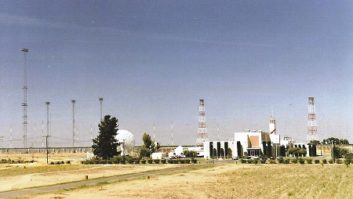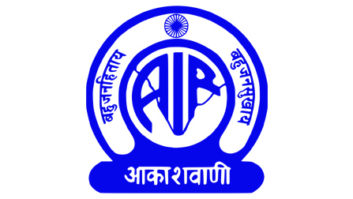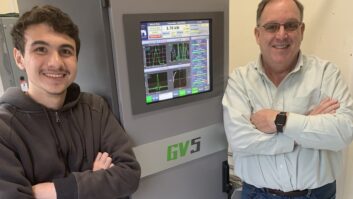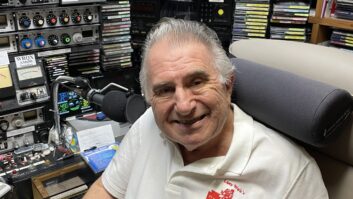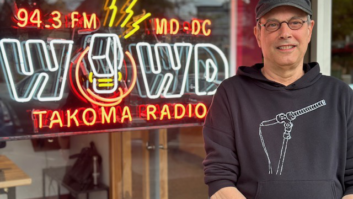GREENVILLE, N.C. — Radio World toured VOA’s Greenville, N.C., facility recently. Photos from our visit are shown here.
Few would dispute that there has been a marked decline in shortwave broadcasting listenership since the end of the Cold War in 1991. Many former large-scale international broadcasters have cut schedules sharply, or have ended HF radio transmissions altogether.

Administrative and broadcasting operations at the VOA’s Greenville Site B take place within this 23,308-square-foot building. The facility was completed in 1963. Today 16 full-time federal employees and three contract technicians work there.

Other than the airing of recorded identifiers, all audio transmitted from Greenville is produced in Washington studios and delivered to the transmitting station via satellite. Audio feeds are monitored in this control room located between the plant’s two transmitter corridors. At present, the station transmits some 2,300 hours of programming each month.

Greenville Site B remains the single largest radio transmission plant in the United States. The transmitter building houses eight very large transmitters; all typically operate at 250 kW and two can provide 500 kW of HF energy if required. There’s also a 50 kW unit kept for backup and testing purposes. It was most recently used for evaluating DRM performance in the HF bands.

This switch gear funnels the large amount of commercial AC power to the facility’s various transmitters. The station consumes approximately 1 million kilowatt hours of electricity each month.
While the International Broadcasting Bureau, which oversees Voice of America operations, has closed a number of its domestic and overseas transmitting facilities (relay stations) and moved into placement of programming on AM and FM outlets in countries where a VOA presence is desired, it still provides thousands of hours of programming for shortwave listeners every month.
At one time the government’s domestic HF broadcasting activities involved several large shortwave transmitting plants located in Ohio, California and North Carolina. Today, only one remains; it’s located here amid Carolina farm land and forests just a few miles from downtown Greenville. It’s officially known as the Edward R. Murrow Transmitting Station and actively beams out programming in the international broadcasting spectrum on a daily basis.

Greenville Transmitting Station Chief Engineer Macon Dail and Plant Supervisor Eric Kehew hosted our tour. They’re seen with the control console for one of the Continental 500 kW units. The transmitters at Greenville come from several manufacturers, including AEG-Telefunken, Brown Boveri Corp., Continental and General Electric. The earliest date back nearly 50 years, having been installed when the station first went on the air.

The tour included a visit to the transformer vault of one of the GE transmitters. RW’s Paul McLane is seen here amid the power supply components, just inches away from a (de-energized) ‘touch it and you die’ busbar.

The conductors seen here provide an indication of the magnitude of voltages and currents encountered in the massive transmitters.

You don’t cool tubes in a 500 kW transmitter by just blowing on them. A very large supply of chemically pure non-conductive cooling water must be circulated between transmitters and heat exchangers. These are some of the pumps, reservoirs and cooling lines installed at Greenville’s Site B for that purpose.

Thousands of spare parts, including large and small vacuum tubes, are kept on site to maintain the huge shortwave transmitters. The facility also has a complete machine shop for fabricating transmitter components and assemblies that are no longer available from their manufacturers. Whether it will remain active much longer is in question. As part of its 2011 budget submission, the Broadcasting Board of Governors proposed closing the last U.S.-based shortwave broadcasting center at an estimated cost savings of $3 million per year.
When the station first took to the air in February 1963, it was one of three VOA facilities constructed here. The sites were designated “A,” “B” and “C,” and ringed Greenville, forming a triangle with its vertices roughly 20 miles apart. In its heyday, the Greenville operation was the largest broadcasting site in the world.
Site C served as the operation’s “receive” site and was linked to the VOA’s Washington studios by both a dedicated interstate microwave system and AT&T Long Lines service. It distributed programming to transmitters located at the “A” and “B” sites, and also served as an administrative center. Equipment installed at “C” included a large number of HF antennas and diversity receivers for reception and relay of shortwave broadcasts from anywhere in the world.
That facility was closed and dismantled in the mid-1990s, with a consolidation of operations to the “A” and “B” transmission sites.
Site A was deactivated several years ago and placed in “mothball” status, leaving Site B as the only operational Greenville VOA facility.
Although its operations have been scaled back from the “glory days” of 40 or so years ago and its future has been put in question, Site B still ranks as the largest radio transmission plant in this country and, at least for now, remains an active and impressive radio broadcasting facility.

This building is located behind the main transmitting plant and encloses a massive remotely-controlled high-power RF routing switcher for channeling transmitter outputs to various antennas.

Some 25 miles of heavy open-wire feeders connect the high-power RF routing switcher to the site’s 38 transmitting antennas, which are spread across nearly 2,800 acres of North Carolina countryside.





